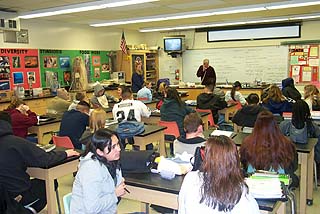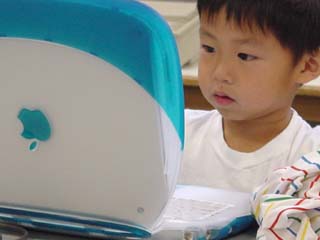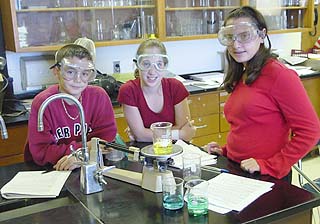
DJC.COM
August 20, 2002
Building schools fit to compete
Franklin Hill & Associates

Courtesy of Franklin Hill & Associates Students in the back of this classroom are sitting more than 40 feet away from a wall-mounted TV. Recent studies have demonstrated that some students can perform better than others simply by where they sit in the classroom. Environmental effects such as glare, poor acoustics and lighting have been shown to affect classroom performance. |
In the old days, educational excellence was defined as being better than the school district next door. This might include winning more Friday night football games, a slightly better grade point average, and a few more kids going to college. This is no longer an acceptable standard. Times have changed.
Today, top-notch school districts around the country see competition as a national, and even international responsibility, where performance standards are getting tougher and the best colleges and technical schools are far more selective.
Successful school districts have to think smarter and increase efficiency while improving quality learning and quality facility design. Fortunately, good planning and smart solutions can be cheaper and more effective than ever before. A few trends are:
General classrooms
|
These spaces are getting slightly bigger even when class sizes are getting smaller. Multimedia, small-group activities and immediate electronic access to information are now commonplace in general classrooms. Wireless systems and information at one’s fingertips create faster, higher-order thinking skills in a fashion similar to the “virtual office.”
Resource areas
Clusters of classrooms surround resource areas where students can work in a conference-room-like setting or at an individual electronic office-like learning station. Talented individuals can reach their highest potential while still being grounded in the reality of working with others towards a successful common task.
Media centers
Whereas media centers grew larger and larger for years with more centralized technology, now decentralized wireless laptops make information access happen mostly from the classroom. The use of thick, heavy books is only a periodic occurrence. Thus, libraries are often getting smaller in favor of a “building-wide” library and information structure. Why store 25,000 books in the centralized school library? We’re not doing away with libraries; we’re just making the whole school a library.
Science

Courtesy of Franklin Hill & Associates Electronic access to information is now commonplace in general classrooms. Wireless systems and information at one’s fingertips create faster, higher-order thinking skills. |
Some districts complement their lab experience with as many as 15 electronically based peripherals measuring temperature, velocity, light levels, sound levels and much, much more. Combining electronic devices with hands-on lab experiences is changing the shape of the lab station, electrical requirements, lighting demands, and even acoustical management. The shape and dimensions of the science lab are changing drastically. Yet the overall classroom can be less expensive to build.
Design impacts learning
Recent studies have demonstrated that some students can perform better than others simply by where they sit in the classroom. Environmental effects such as glare, poor acoustics, lighting, etc., have been shown to affect classroom performance. The better districts are correlating learning styles to the design of the environment in order to allow every child equal educational opportunity, maximum performance and fewer negative environmental impacts.
Industrial arts vs. technology education
Many high schools are still forcing auto-shop studies because the room exists and a teacher is still on staff. Yet few of the teachers have the technologies and skills necessary to train a student for a true automotive career. Dynamometers are too expensive, safety requirements too extreme, and the variety of automobiles too sophisticated.
Technology education is coming to the forefront as a simpler, hands-on, problem-solving curriculum that provides many more activities of a more complex, higher-order nature in a shorter amount of time. Even students with poor reading skills are excelling, and absenteeism is a thing of the past.
Yet some tech-ed labs remain “on the back 40” like the dirty auto shop or welding room of the past. Smart schools place these functions near science as part of the core curriculum instead. Schools of the future are seeing the whole system of learning as an integrated package, not bits and pieces scattered around the building.
Corporate partners
Corporate partners are blending with the K-12 and university systems as one unit. Some industries occupy space on site and establish mentor programs as well as an income base for underenrolled facilities. Other examples have students leaving the school early to attend training on site, allowing the building to be even more efficient to schedule additional students.
Corporate training centers
Corporations are updating adult skills more than ever before in house. Properly planning corporate learning centers for safe, 24-hour use is essential. Practicality for multicultural needs and different learning styles based on culture, sex and age must also be considered in the design of the building.
Schools get smaller

Courtesy of Franklin Hill & Associates
Combining electronic devices with hands-on lab experiences is changing the shape of the lab station, electrical requirements, lighting demands and even acoustical management.
|
Many people encourage smaller schools, yet, when too small, they are too expensive to maintain or can’t provide diverse quality programs. Smart schools are expanding elementary grade-level configuration from kindergarten through even eighth grade. Proper design can differentiate functions for safety while the enrollment is large enough to maintain the teaching staff and varied, challenging programs important to each grade level.
Some districts have moved to having kindergarten through 12th grade on one campus, which can produce the incredible benefits of a small, boutique, private school while having the economies of scale necessary to fund nationally competitive programs in science, art, music and technology.
The Disney school
The 1993-built Celebration School outside of Orlando, Fla., has been a benchmark for many continuing practices in both remodeling and new construction. This kindergarten to 12th grade facility maintained diversity of age, culture and talent with the economies of size in a small and intimate learning environment. In many ways it has become the national model for elementary, middle and high school designs over the last 10 years, such as providing resource areas, clustered classrooms and team teaching offices.
The most fundamental, overriding theme in successful school districts appears to be changing the core attitude about learning and extending the joy of learning over a lifetime. A major stumbling block toward this end is fear of change. Systemic, whole-systems reorganization of education demands a forthright and personalized strategy for overcoming fear of change.
Typically, school districts spend more money on capital construction and remodeling than any other company, municipality or governmental agency. They do it as a large, multimillion-dollar, one time expenditure, which is often long overdue. It is essential that such situations be met with objective, informed decision-making and an awareness of options around the country, not just the region.
A lot can be learned effectively and efficiently that can produce more cost-effective, functionally flexible and dynamic learning facilities for K-12 education, universities and even the corporate learning environment. Comprehensive pre-planning is essential, timely and cost effective in the long run. Making adjustments and changes during design and construction is far too late, expensive and ultimately delays the project substantially.
Franklin Hill, Ph.D., of Bellevue-based Franklin Hill & Associates, is a national educational facilities consultant working in the areas of curriculum change, technology, and facility design. Hill has planned more than 200 schools across North America.
Other Stories:
- Mount Tahoma High plans to break the scale
- Green features encourage schools to lighten up
- More funding is needed for school construction
- State’s two-year colleges face a space crunch
- More public schools seek private funds
- Artificial turf has come a long way
- Designing schools that work for all kids
- State takes a cue from the private sector
- Third-party code reviews save schools time, money
- Independent schools need a road map
- Moving right along
Copyright ©2009 Seattle Daily Journal and DJC.COM.
Comments? Questions? Contact us.